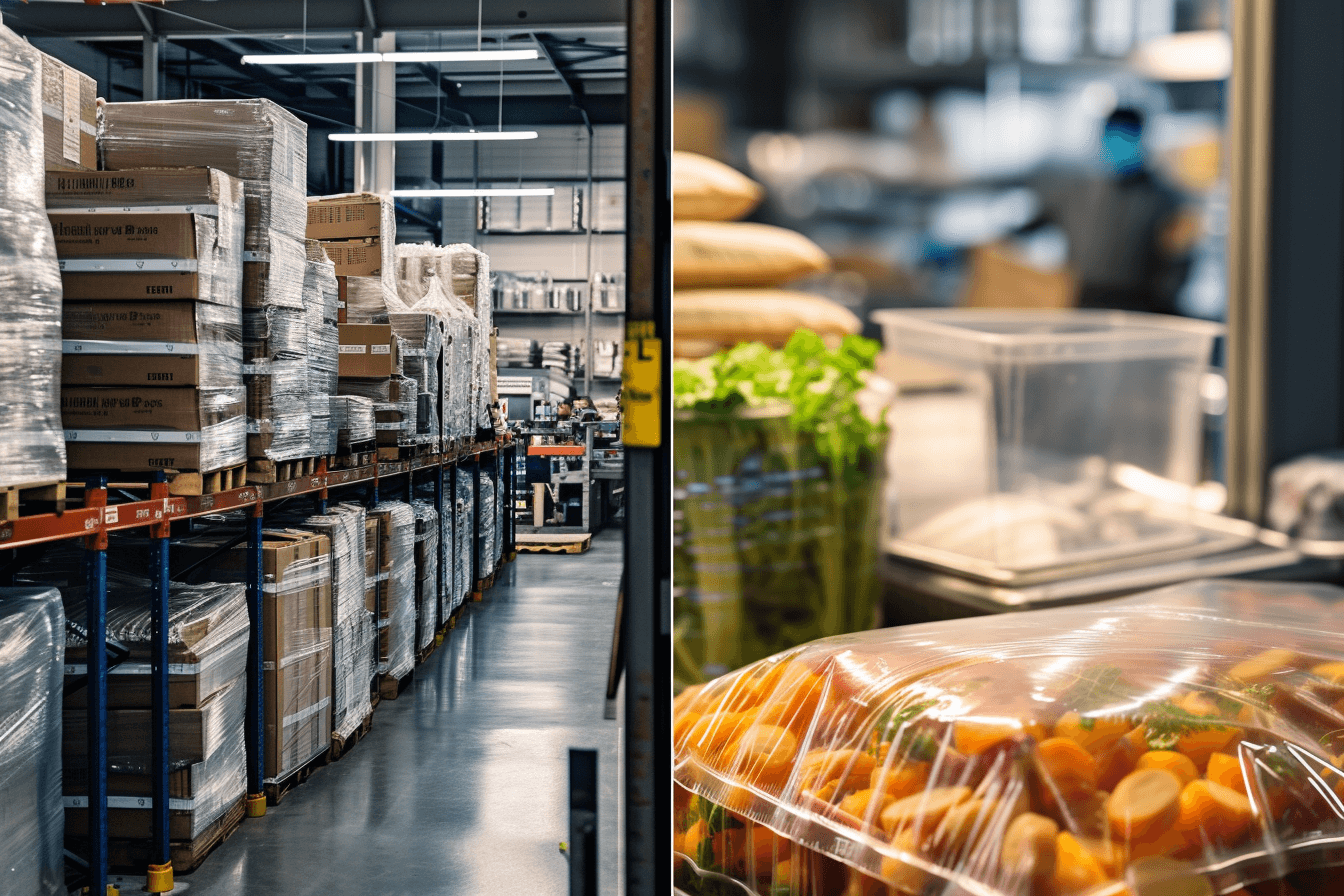
In food packaging and preservation, two commonly used films are stretch film and food cling wrap. It’s important to understand the differences between these materials to choose the right one for specific needs.
This article will look into the characteristics, uses, and pros and cons of stretch film and food cling wrap, providing insights into their unique features.
Stretch Film and Food Cling Wrap for Packaging
1. Stretch Film
Stretch film, also known as stretch wrap or pallet wrap, is a versatile packaging material designed to stretch and conform tightly to the items being wrapped. Made from materials like polyethylene and polyvinylidene chloride, stretch film finds its primary applications in industries such as logistics, warehousing, and shipping.
The film’s primary purpose is to secure and stabilize loads during transportation and storage. Its stretching capabilities, combined with strength and durability, make it an ideal choice for heavy or bulky items.
2. Food Cling Wrap
Food cling wrap, also known as plastic wrap, food wrapper, catering cling wrap, or saran wrap, is a versatile, thin, and flexible film designed to adhere seamlessly to itself and various surfaces. Typically made from polyethylene, this transparent film is a common choice in catering, cafes, and restaurants due to its reliable tight seal, which effectively protects and preserves food. Whether used for wrapping sandwiches, covering dishes, or storing leftovers, cling film is an essential tool in both household and commercial kitchens.
Cling film’s self-clinging nature creates an airtight seal, keeping food fresh by preventing moisture loss and ensuring hygiene. It’s ideal for storing vegetables and fruits, maintaining their freshness and presentability. Whether you’re prepping, cooking, packaging, or controlling portions, catering cling wrap is a dependable solution that helps retain moisture and prevents odour and flavour transfer.
Its crystal-clear transparency allows for easy inspection of stored food, making it a multipurpose, convenient, and portable option for food storage and preparation. Additionally, it adds a layer of hygiene and neatness, ensuring food remains safe and visually appealing.
Material and Thickness Differences
1. Stretch Film
Stretch film is typically made from polyethylene or polyvinylidene chloride, making it thicker and stronger compared to cling film. This thickness provides enhanced protection against punctures, tears, and shifting of goods. Available in various gauges to accommodate different load sizes and weights, stretch film is a durable and suitable choice for heavy-duty applications.
2. Food Cling Wrap
This plastic wrap for food is primarily made from polyethylene and is thinner and more flexible compared to stretch film. While it may not offer the same level of strength, its self-clinging nature and static charge allow it to adhere tightly to surfaces, creating a secure and airtight seal around food items.
Their Differences in a Nutshell
While both stretch film and food cling wrap fall under the category of plastic wraps used for packaging, each material serves different purposes. Pallet stretch film excels in industrial packaging, securing cartons and pallets during transportation, thanks to its exceptional durability and elasticity.
On the other hand, food cling wrap specializes in protecting food items, increasing their shelf life without compromising quality.
Choosing the Right Option Between Stretch Film and Food Cling Wrap
When it comes to choosing between stretch film and food cling wrap, it is important to consider the specific needs and applications.
For Industrial and Logistics Use
If you are dealing with the transportation and storage of heavy or bulky items, stretch film is the ideal choice. Its excellent load retention and stability make it a go-to solution for securing loads on pallets.
For Food Preservation
When the primary goal is to preserve the freshness and quality of food, cling film should be the first choice. Its airtight seal and versatility in household and kitchen applications make it a reliable choice for wrapping and storing food items.
Can They Both Wrap Food?
In many instances, both stretch film and cling film can be used to wrap food, dispelling the notion that their usage is strictly limited to industrial or household settings, respectively. Stretch film can be employed to wrap food containers, providing stability and protection during transportation. At the same time, cling film can be directly applied to the food itself, creating an airtight seal for preservation.
In Summary
The choice between stretch film and food cling wrap depends on the specific needs and applications. Stretch film proves to be an invaluable use in industrial and logistics settings as it excels in securing and stabilizing heavy or bulky items during transportation and storage.
On the other hand, food cling wrap is the preferred option for food preservation, with its thin and flexible nature, creating an airtight seal that extends the freshness and quality of food items.
While each material has its different strengths, it is worth noting that both stretch film and cling film can be versatile in their applications. Stretch film can contribute to stabilizing food containers during transportation, while cling film, with its unique characteristics, can be directly applied to food, ensuring a secure preservation seal.
All in all, you should choose the packaging material that matches your needs.





